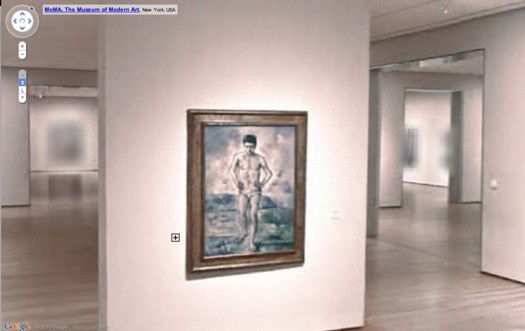
Alright, this is kind of killing me right now, not just with its awesomeness, but because I have been planning to do a very similar project, and also because like half my blog these days could be called Google Art Project, and well…
But let me agonize in private while we first praise the awesome. Google has released Street View-style navigation for galleries in seventeen major museums around the world, including the Museum of Modern Art. MoMA’s only got the lobby and one room on there, the first gallery on the fifth floor, which contains Cezanne’s Bather and Starry Night.
The resolution and color look awful, frankly, but who cares? It’s Starry Night as you’ve never seen it before–in an empty gallery. But still. Check out the background, what they had to do to all the artwork in the adjacent galleries, the stuff they didn’t clear the rights for:
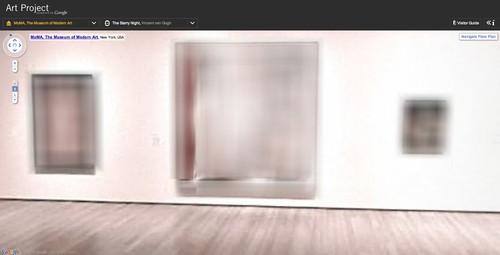
That’s Les Demoiselles d’Avignon there in the middle:
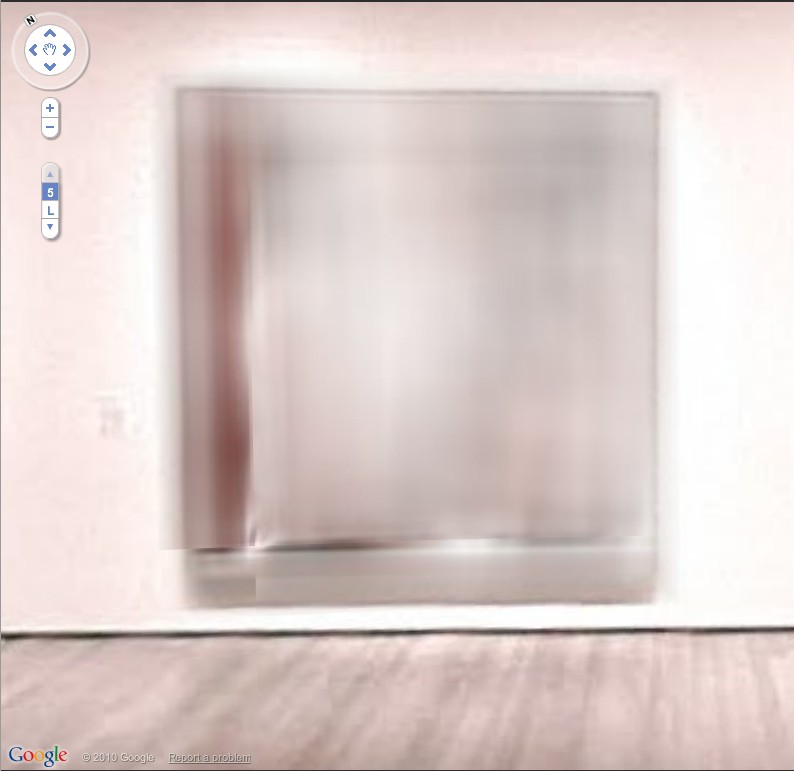
Which makes this, Picasso’s Boy Leading A Horse:
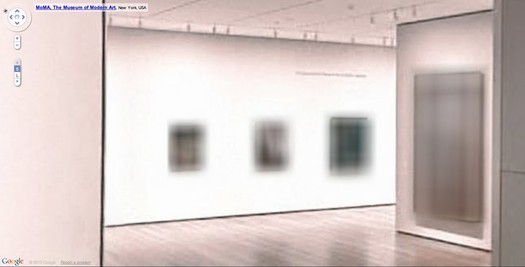
What’s crazy is that whatever’s hanging next to Rousseau’s Sleeping Gypsy is blurred out, too. By definition, it has to be in the public domain, right? 19th century? What is it?
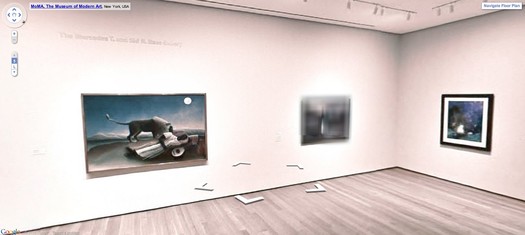
The shoot for The Googlecam Was Present seems to have taken place almost a year ago; in the lobby, Marina’s still listed as “coming soon.” And they’ve rehung Gallery 1, there, so it’ll take a little flickrdiving to figure out what that was.
UPDATE: Thanks to MoMA scout Dan Phiffer, the work is identified as Edward Munch’s 1893 painting, The Storm.. [Munch died in 1944, so depending on which copyright regime applies, it may not enter the public domain until 2014. The image of the painting on MoMA’s website is rather boldly claimed to be copyright 2010 by the Munch Museum.]
But meanwhile, I’m prowling the other 16 museums for more blurred material. Richter must be so pissed right now.
Previously: Blurmany and the pixelated sublime
Sherrie Levine’s Meltdown series
Color Me Interested
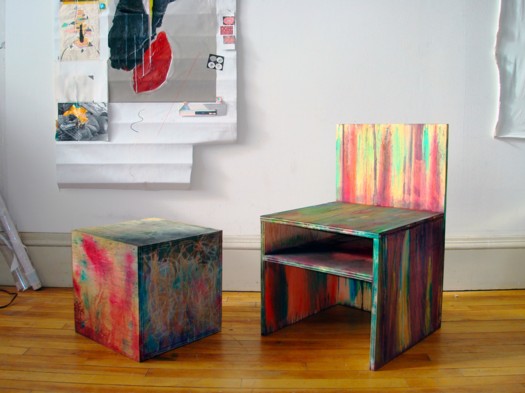
Not sure what this psychedelic Juddy chair/sculpture colabo they’re doing with Eric Timothy Carlson is about, but anything RO/LU does has my undivided attention, even if they didn’t quote my favorite Joe Bradley review. [via rolu]
[2020 update: RO/LU alumnus Matt pointed out that Frieze has deleted Chris Sharp’s 2008 review of Joe Bradley’s CANADA show, so here it is, exhumed from the Internet Archive [CW: offensive ableist slur]
This will be a very un-politically correct piece of art criticism. The faint of heart are encouraged to stop reading now. That said, I was recently impressed to hear a New York artist criticize, with distinctly un-PC disdain, a fellow artist for producing work that was ‘not retarded enough’. ‘Retardation’ being the acme of advanced art and any un-self-conscious betrayals of earnest intelligence an act of philistinism, it is as if, over the course of the past five years, a kind of compulsory Dada has integrated itself into the fabric of a good deal of New York art-making. The higher the ‘durr’-factor, the better, apparently, the art. And with this exhibition at CANADA, entitled ‘Schmagoo Paintings’, Joe Bradley has thrown down the ‘durr’ gauntlet. Because it doesn’t get much more retarded than this.
Departing from the slightly less ‘durr’ primary-colour minimalist figures he showed at the Whitney Biennial this year, Bradley has produced an exhibition of seven mid-size ‘paintings’ on unprimed canvases (all works 2008). Six of the seven works bluntly feature stick figures, grease-pencil drawings which can be read as: a human figure, a fish in an open mouth, a cross, a Superman symbol, the number 23, and a line towards the bottom of a canvas (a deadpan mouth?) – while the seventh, titled Untitled (Schmutz Painting), bears nothing but the dirt from the floor upon which it was stretched. There is, incidentally, a lot of schmutz, for the same reason, on the other works as well.
One thing that can said about Bradley’s work is that it responds to the art-fair attention-span of our time. It can (and should) be consumed in no less than the time it takes to walk in, chortle, and walk out of the gallery. When Martin Barré (a very generous reference) did just as little with white canvases and black spray paint in the early 1960s, it was radical and even beautiful. But here and now with Bradley it is just plain dumb, though that is the point. Whether I, or anyone, likes it or dislikes it is actually beside the point. Which is also very much the point. This kind of work wields the uncanny ability to render all who enter its orbit complicit. It’s a kind of 2008 Lower East Side counterpart to Jeff Koons – though rendered much more poorly. Squarely operating within a paradigm of post-sincerity – it is neither sincere or insincere, having transcended such issues – its mere existence acts as a cerebral black hole, engendering critical paralysis. Any possible reaction you may have to it has been foreseen and theoretically integrated into the work, such that reacting is vain. Whether you like it or not, you’re a fool. And if you profess indifference to it you’re likewise a fool, because such painterly antics require a stand that no one can make. It’s like a work of high modernist fiction – Borges, or Cortazar perhaps – in which you realize that you are part of the plot, but by the time you do – standing in front of the painting or reading this review – it’s too late.
Les Ballons de Léon Gimpel
Last week in my interview with Mike Maizels for Pinkline Project, I’d mentioned how the Grand Palais in Paris would be an acceptable art venue for exhibiting my satelloon project. Not only was the grand nave one of the few spaces in the art world that could accommodate a 100-foot diameter inflated aluminum sphere; but historically, it was the site of major, early air shows, and it has held giant balloons before.
As new greg.org reader Erik points out in this awesome color [!] photograph, which was taken in 1909 by Léon Gimpel.
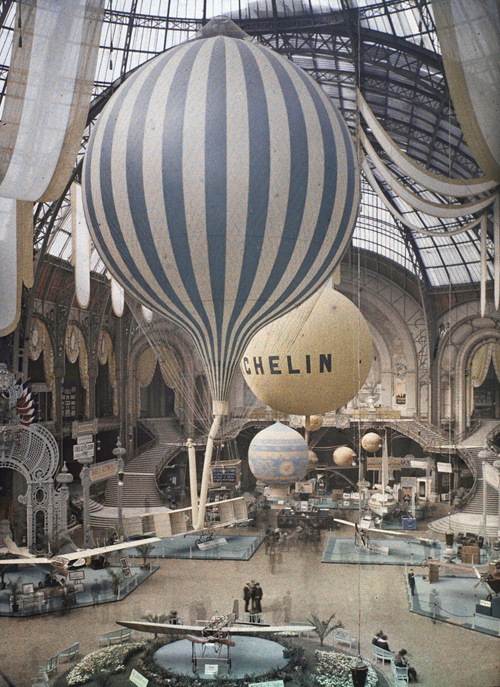
I didn’t know Gimpel, but the Musee d’Orsay says I should be as familiar with his work as with his Belle Epoque confreres Lartigue and Atget. They staged a retrospective of Gimpel’s pioneering photography in 2008. Apparently, he experimented with distorting mirrors, perspectival compositions, and color photography. He published the first color news photo, using the Lumieres’ autochrome technology [the same as above] just days after they introduced it. And though I can’t find examples of it yet, his aerial photography sounds pretty sweet:
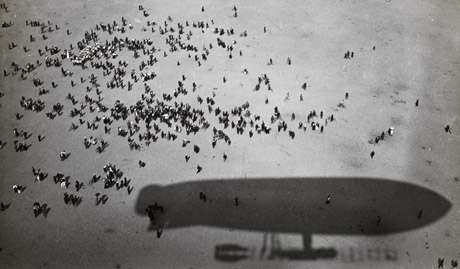
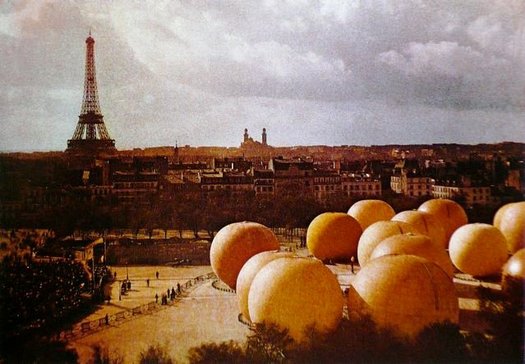
From 1909 onwards L’Illustration commissioned photo reports directly from Gimpel. He stood out from other photojournalists by producing unusual images. At the first major air show, held at Béthény in August 1909, he went up in an airship and so was able to photograph the progress of the aircraft, not from the ground like the other photographers, but from the sky. So, thanks to Gimpel, readers of the magazine had a stunning view of the pioneers of aviation.
From this date, the photographer started to exploit this bird’s eye view in order to set himself apart from other reporters and to seduce the press.
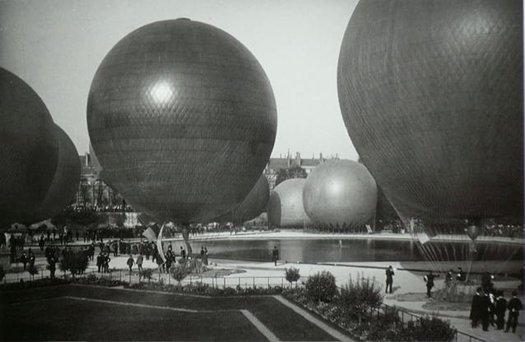
[update: found some via fantomatik]
Fortunately, there’s a catalogue. Unfortunately, it doesn’t look to be readily available in the US. Judging from the cover, though, I could probably ask Ricci Albenda to lend me his copy.
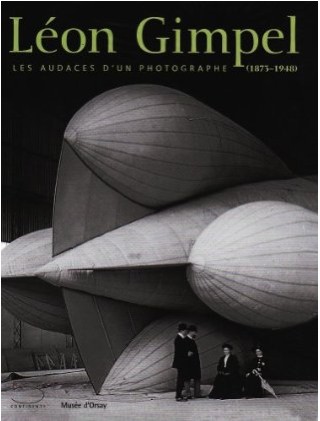
Léon Gimpel (1873-1948), Les audaces d’un photographe [musee-dorsay.fr via ck/ck, the equally awesome tumblr of Swedish designer Claes Källarsson, thanks Erik]
More Gimpel images: La guerre des Ballons de Leon Gimpel [fantomatik]
I’m Sure There’s A Product Here Somewhere
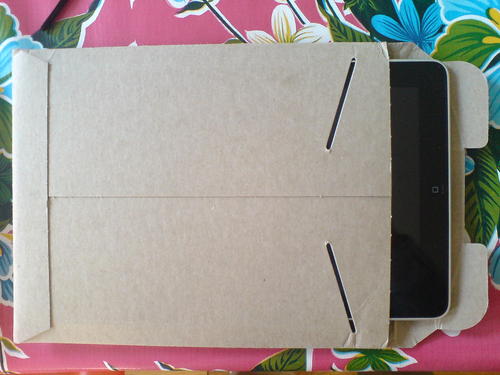
Yesterday I was looking around for something to take my iPad on the train, and I saw that it fits perfectly in the thick cardboard envelope my Cabinet magazine came in.
I love the idea of a found, cheap, repurposed iPad case that provides a decent amount of protection. But I also wonder if this could work even better in a slightly more advanced material. Maybe Kickstart a development plan, test out some small batches in various Kevlars and polycarbonates and whatnot.
Or maybe low-profile, recyclable cardboard is where it’s at. You could subscribe, and they’d send you a new iPad case when they start to wear out, maybe every quarter. And maybe entice you with a free magazine inside.
$31/100ct is a pretty good price for 9×11.5 inch kraft mailers. [esupplystore.com]
Amazon’s got 100ct for $49, which is alright. [amazon]
Having A Cow
After dropping in on the National Portrait Gallery’s daylong symposium [it’s still going on, in fact] connected to Hide/Seek just now, and though I only saw two presentations, whoa–I feel like a cigarette.
Jonathan Katz, co-curator of Hide/Seek, titled his paper: The Sexuality of Abstraction: Agnes Martin, and he rather amazingly addressed Martin’s embrace of the substantive stasis of Zen as an alternative to the more prevalent and problematic model of the closet for not addressing her lesbianism. Which she at once did and did not do in some of her formative early New York work, and which she very much did not do when she wrote and talked so extensively about her work.
One particular work, a 1961 drawing titled Cow, for example, has been traced to an illustration in her D.T. Suzuki book, where an oxherder and an ox contemplate a circle in a square. And then Katz read a quote from the artist’s statements from one of Martin first shows in NYC, in which she quoted a famously, directly erotic Gertrude Stein poem–but stopped right before the hot parts. And–who knew? not I–he read some other famous-among-lesbians poem where Stein rather rhythmically builds up, and up, and up, to the moment of climax–which is symbolized by a cow. Suffice it to say, Katz’s phrase, “Stein’s orgasmic cows” is now right next to Gorky’s “cosmic vulva” in the modernist discourse. [Holy smokes, I just Googled “cosmic vulva” and Gorky and came up empty. Have I not told that story? My apologies. Let me rest up, and then I’ll get right back into it. I’m not 19 anymore, you know.]
Anyway, hot on the heels of Martin’s Zen sex koans, Dominic Johnson presented work from his forthcoming book on Jack Smith’s 1963 film Flaming Creatures and what he calls the “burden of disgust.”
I’d heard the general story of the obscenity controversy around Flaming Creatures, prints of which were seized by police, and became the basis for several criminal obscenity cases and appeals. But I had no idea that when Lyndon Johnson was nominating Abe Fortas to be Chief Justice of the Supreme Court in 1968, conservative senators, led by Strom Thurmond, raised Fortas’s criticism of the Flaming Creatures convictions as evidence of liberalism’s inherent perversity.
And that to make his point–are you sitting down? You really should be sitting down–Thurmond organized a Senate screening of Flaming Creatures during the Fortas hearings. And he sandwiched Smith’s avant-garde piece between a random strip-tease film, and a couple of run-of-the-mill straight hardcore porn flicks. At the Senate. Charles Keating apparently told Newsweek that the film was so disgusting, it didn’t even arouse him. This he told to Newsweek.
Sometimes it feels like you think you know the world you’re living in, and sometimes, wow, you just don’t.
WOW, HAS IT BEEN TWO YEARS? UPDATE I was searching to see about Johnson’s Jack Smith book, and I found the videos of the “Hide/Seek” symposium presentations, so I added them here. Good times.
Meanwhile, the book, Glorious Catastrophe: Jack Smith, performance and visual culture, was released last summer. I haven’t seen it, or any reviews of it, which seems unusual.
Pebble Beach Pollock Revealed! Or Scenes From A Boston Marriage
So much history-making postwar art missing, so little time!
The Pebble Beach Art Heist had gone cold for a while, but now, thanks to a new website [“made on a Mac”!] it is flaming back to life. And for the first time, we get to see a photo of what is surely one of the Most Important Missing Paintings In The World: the Pebble Beach Pollock.
Continue reading “Pebble Beach Pollock Revealed! Or Scenes From A Boston Marriage”
Haven’t Found Tacita Dean’s Sound Mirrors Yet

Maybe it was me looking for Tacita Dean’s Sound Mirrors that brought me there, but David Williams’ 2009 post at Skywritings about Dean, Derek Jarman, Dungeness, gardens, Tehching Hsieh is pretty wonderful:
Everything here has been found, salvaged, re-cycled from this sea-edge place, and is both displaced and quite at home. A manifest testament to qualities of patience, economy, playful invention and a quiet contemplative thusness. For the garden stages a deep acceptance of being here in all modesty and attentiveness. Taking time to make space. Slow time, still moves. A bricoleur Picasso meets the Zen garden.
Jarman bought the house in 1986 for £750; he was scouting for bluebells with Tilda Swinton and Keith Collins for a film shoot. He called it his ‘paradise at the fifth quarter’, a place where he could walk in the ‘Gethsemane and Eden’ of his garden and ‘hold the hands of dead friends’ (Garden).
(Once, when my mother was very ill in hospital, she told me that her mother had just visited her, what a shame I’d missed her. She had knocked on the window, told her that she should ‘come out into the garden’, it was good out there, and it was time. Her mother had died more than ten years beforehand).
Still looking for that Sound Mirrors piece. I suppose I should just go to the gallery.
In fact, skywritings is good all over. [sky-writings.blogspot.com]
An Avalanche Of Awesome

I’ve been kind of busy, and I didn’t want to get fingerprints all over the signed edition, and my few original issues are in storage somewhere, so I’m really only now getting a look at Primary Information’s beautiful facsimile copy of Avalanche magazine. I’m on page nine and I’m tempted to blog my way through the whole thing. Just so much going on. Here’s a taste from Avalanche No. 1, Fall 1970, from Rumbles, the front-of-the-book, which reads like the alumni news section of Conceptual Art University:
James Turrell, 27-year-old LA sculptor, who has not formally exhibited since his only one-man show of projected light works organized by John Coplans at the Pasadena Art Museum in 1967…In April 1969, Turrell and Sam Francis made a sky drawing using two World War I biplanes, radio-controlled from the ground, as part of Easter Sunday in Brookside Park organized by Oliver Andrews, Judy Gerowitz [!] and Lloyd Hamrol, who participated with elemental outdoor projects…
…
Work began this summer on Paolo Soleri’s Arosanti, a rural housing complex for two thousand inhabitants on a seven acre site seventy miles north of Phoenix, Arizona…
…
The Museum of Conceptual Art opened on Wednesday, March 18 in San Francisco’s Market Street district with a participatino piece in which buckets of paint were given to the guests to paint the walls white….MOCA’s latest show, Sound Sculpture As a one night presentation of successive sound events by ten Bay Area artists, was held on April 30…Allan Fish‘s piece was performed by Tom Marioni. Perched atop an eight foot ladder, he pissed into a galvanized washtub. As the tub filled, the sound dropped in pitch. He was followed by Terry Fox, who scraped a shovel across the linoleum floor and vibrated a thin plexiglas sheet very fast. Jim McCready paraded four girls wearing shiny nylons down a 3×9′ long rug. As they rubbed their thighs together a swishing sound was heard….
…
Andy Warhol…now has financial backing for his first Hollywood-based film, Specimen Days, the story of Walt Whitman’s experiences as a Civil War male nurse. With shooting set to begin around mid-October in New Orleans, the regulars are ready but the lead is still to be cast. Allen Ginsberg, Mick Jagger, and John Lennon have all turned it down.
…
After his recent New York visit, LA based artist Terry O’Shea has returned to California and plans to execute a large-scale ecological project involving fast-growing plants.
…
The Japanese police detained San Francisco artist Paul Cotton for wearing a pink bunny costume to the Pepsi Pavilion at Osaka’s World’s Fair. John Perreault gave Marjorie Strider his old Iowa summer teaching job so that he could concentrate on his first book for Abrams, Andy Warhol
Ooh, an ad for 9 at Leo Castelli, the seminal show Robert Morris curated at Castelli Warehouse–which was not the Castelli Warehouse from which Jasper Johns’ Short Circuit flag painting was taken, but still.
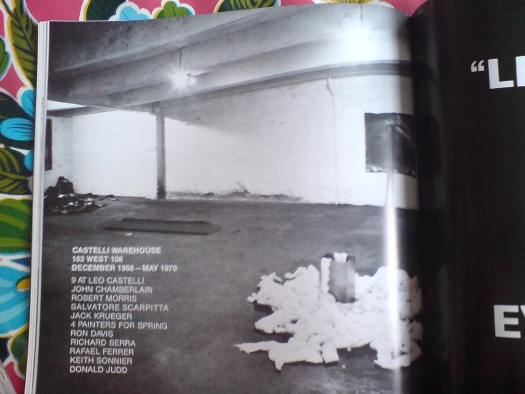
Ooh, a big picture of the misty Pepsi Pavilion surrounded by moving sculptures in the ad for Robert Breer’s show at Galeria Bonino? Where is Robert Breer these days, btw? That’s not a rhetorical question, either.
The trade edition of Avalanche is under $100 at Amazon. The first nine pages, at least, are highly recommended.
Abmassadorial Commodity
John Powers just retweeted it now in parts, and he included it in his epic Star Wars Modern piece at Triple Canopy last year, but this quote from “American Painting During the Cold War,” Max Kozloff’s 1973 Artforum article, is worth repeating again and again:
It signifies a new sophistication in bureaucratic circles that even dense and technical work of the intelligentsia, as long as it was self-censoring in its professional detachment from values, could be used ambassadorially as a commodity in the struggle for American dominance.
Reprinted in Artforum, Kozloff’s piece was originally the introduction to the catalogue for Twenty-Five Years of American Painting, 1948-1973, James Demetrion’s 1973 exhibition at the Des Moines Art Center.
Demetrion would later become the director of the Smithsonian’s Hirshhorn Museum.
The Global Puppy On Terror
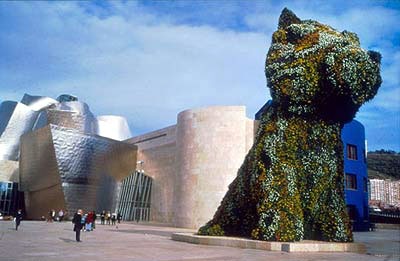
In reviewing Johan Grimonperez’ 1997 film, Dial H.I.S.T.O.R.Y., which was exhibited at Deitch, Ronald Jones underscores artists’ failure to, well, to matter very much in contemporary culture. And he reminded me of this, which I had completely forgotten:
Paul Goldberger’s piece in the New Yorker on Frank Gehry’s Bilbao museum made an important claim: ‘The politics of the Guggenheim Bilbao’, Goldberger writes, ‘are evident in a single word, “MUSEOA”, that is plastered onto the building’s facade in enormous letters’. Goldberger’s point is that, ‘museoa’ is not Spanish but means ‘museum’ in the language of the Basques. We take from the Goldberger essay that a collision between art and politics was inevitable in Bilbao. As a part of the Bilbao Pageantry Jeff Koons’ well known Puppy (1992), the floral sculpture that made its magnificent debut in Kassel a few years ago, was to be erected and brought to life with local flowers. Languidly watching workmen hang pots of flowers over the gigantic pup, the police ran a casual check on the license plate of the truck which had been used to deliver the flowers. The truck and plate did not belong together and that’s how the terrorists were found out. When the police began nosing around they discovered that the ‘gardeners’ were arming the adorable puppy with flower pots containing remote-controlled grenades. After the shoot out, in which one policeman was killed, the florist-bombers, members of the Basque group ETA, escaped. Several have since been arrested.
[via frieze]
Related: Felix Gonzalez-Torres on politics and art
Art In Process: Reading Finch College Museum
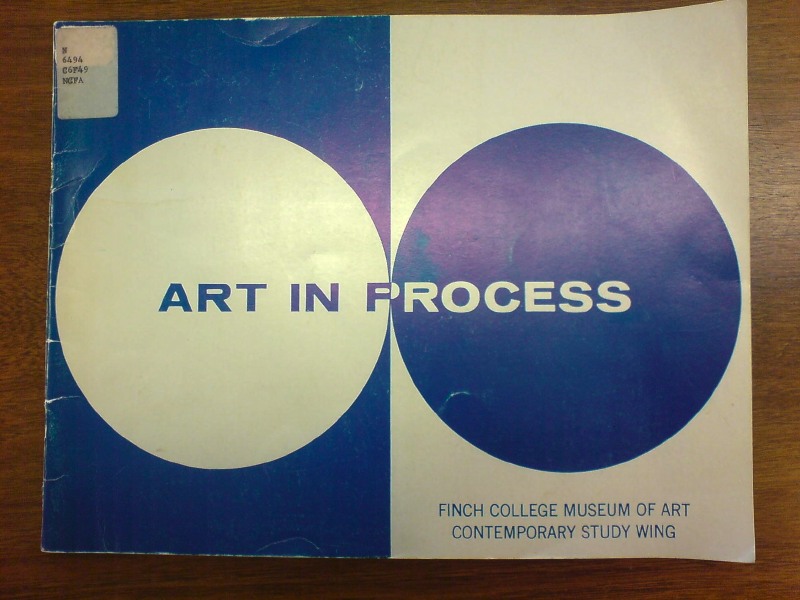
Now we’re getting somewhere, even if it’s only to the library.
Since the Finch College Museum was originally [and wrongly] fingered as the site of the theft of Johns’ Flag from Rauschenberg’s Short Circuit, I’ve been looking for months to buy a copy of the 1967 exhibition catalogue for Art In Process: The Visual Development of a Collage. Well, not so easy. Increasingly desperate and frustrated with the failings of the Internet Age, I decided check the library. Turns out the Smithsonian’s Museum of American Art library, right next door to the Archive of American Art, had a copy. Took like two minutes.
Art In Process was a series of topical, process-oriented, teaching exhibitions organized by Finch College Museum director Elayne Varian. They included sketches, models and studies to show how the artist did what he was doing. From Finch, which was on East 75th Street, the show traveled for 18 months to nine other smaller museums around the country in a tour organized by the American Federation of Arts. [Thanks to the original press release, provided by the AFA, the list of venues is below.]
I’m not the only one who had trouble finding the catalogue, though. Paul Schimmel’s huge Rauschenberg Combines catalogue said the flag painting was stolen while Short Circuit was on exhibit. That’s how he read the entry in Walter Hopps’ 1976 retrospective catalogue, which mentioned Finch and the missing flag together.
But. Check out what Rauschenberg actually said. Well first, check out that photo!
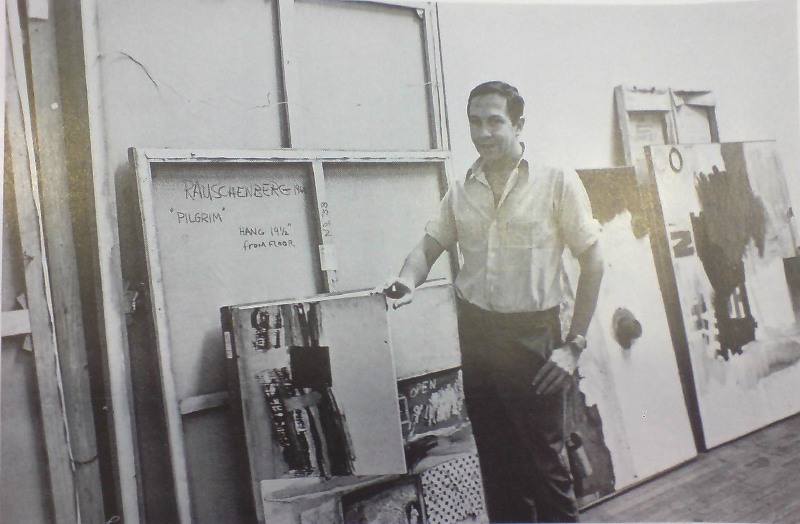
It’s Bob, teasing us with what’s behind Short Circuit Door No. 1. Because there is nothing:
In the third Artist Show at the Stable Gallery, my collage, SHORT CIRCUIT, 1955, was motivated by the protest that there had not been any new artists invited to exhibit. Therefore, I invited four artists: Jasper Johns, Stan Vanderbeek, Sue Weil and Ray Johnson to give me works to be built into my collage. Only two paintings were ready in time to be installed into the major piece. The collage also contains the autograph of Judy Garland, and one of the first programs of a John Cage concert. Because Jasper Johns’ flag for the collage was stolen, Elaine Sturtevant is painting an original flag in the manner of Jasper Johns’ to replace it. This collage is a documentation of a particular event at a particular time and is still being affected. It is a double document.
Give me. Built into. My collage. Only two. Is painting. These are the phrases that jump out at me.
Not only was Art In Process the first acknowledgment of the removal of Johns’ flag, almost two years after it happened, it was the first public exhibition for Short Circuit since Alan Solomon’s group show at Cornell in 1958. After being the subject of some kind of joint, post-breakup negation agreement between Johns and Rauschenberg, where the combine was not exhibited, published, or even, it seems, discussed, Short Circuit went on a cross-country tour, without the flag, and with the doors nailed shut.
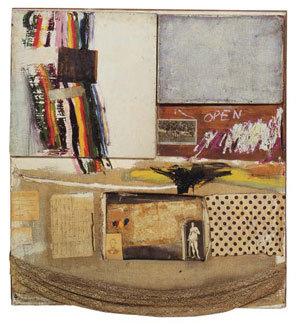
I thought I’d be all Errol Morris about it and date the photograph from the other works in the background, but it doesn’t really help: Pilgrim (1960), on the left without its chair; Johanson’s Painting (1961), in the middle, with the tin cans, was in Ileana Sonnabend’s collection; the other combine painting with the N or Z element, I haven’t found yet. [Any ideas? Send’em in!] That watch Bob’s wearing looks like the one in the Avedon photo on the cover of Schimmel’s Combines, which was taken in 1960. But I’ll say Bob’s face looks a few years older, at least five, if not seven.
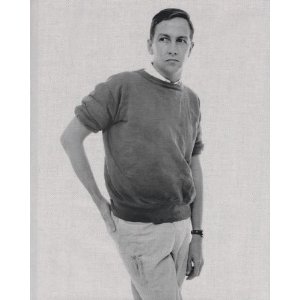
So this photo was probably not, then, taken before 1965. And Johns’ flag painting is probably not, then, behind that door. And Bob is probably not, then, toying with the terms of the no-repro “solution” he and Johns devised for this double document.
Other things: Sturtevant’s flag sounds like it’s in process. Unless that “Sturtevant is painting an original flag” is the same tense as “I am making an animated musical,” somewhere well short of “she’s delivering it this week,” and closer to “well, we’ve talked about it.” Because though a Sturtevant flag sighting was reported in 1971, There were no photos of Short Circuit for Hopps to publish in 1976, and Rauschenberg talking of painting a flag himself because he “need(s) the therapy.” And when David Shapiro and Hirshhorn curator Cynthia McCabe scouted the combine out in 1985, they had a “very sad experience” looking at the work, in a “state of real disrepair,” with mentions only of the absence of Johns’ flag and none of Sturtevant.
No mention of Ray Johnson’s inclusion. How classic for Johnson’s own collage that it gets subsumed so totally as Rauschenberg’s. It’s as if only the paintings can hold their own against the combine’s powers of assimilation. Resistance is futile. I guess that’s the real question here.
For Johnson, though, it’s probably the giddy answer. He was also included in Art in Process on his own, so don’t sweat for him. If anything, that’s how he wanted it. Here’s writer/artist/curator Sebastian Matthews:
Over the next decade, Johnson made a series of anti-rectangle collages. It wasn’t long before Johnson was mailing out collage fragments “for others to use or send on,” letting go authorship (at least in part) and allowing the work to be formed by increasingly random collaborations. No coincidence, then, that Johnson made this creative leap during his transition from Black Mountain to New York City while hanging out with his BMC buddies.
That’s from Matthews’ proposal/thesis for an awesome-sounding show, BMC to NYC: The Tutelary Years of Ray Johnson, which he organized last fall at Black Mountain College + Arts Center in Asheville, NC. Sounds like Short Circuit was as formative and in harmony with Johnson’s emerging practice as it was problematic for Johns’. That may be too simplistic, but it’s way past time to take a closer look at the rest of Short Circuit, too.
The dimensions: The Finch catalogue lists the dimensions for Short Circuit as 48 x 48 inches, which, since Bob was not seven feet tall in that picture, is obviously wrong.
Another reason for checking the Finch catalogue was to see whether Short Circuit was still owned by Rauschenberg or, if it was still, as Michael Crichton reported, in Leo Castelli’s collection. And it doesn’t say. But the press release might. Artists, like Al Hansen, were listed as lenders for some works in Art In Process, but works were credited to the artists’ dealers. Short Circuit was apparently lent not by Rauschenberg, but by Leo Castelli Gallery. The mounted photocopies of letters to Ray Johnson, Stan Vanderbeck [sic] and Susan Weil, meanwhile, were lent “anonymously.” Wait, the what?

Continue reading “Art In Process: Reading Finch College Museum”
People Sitting In Front Of Me
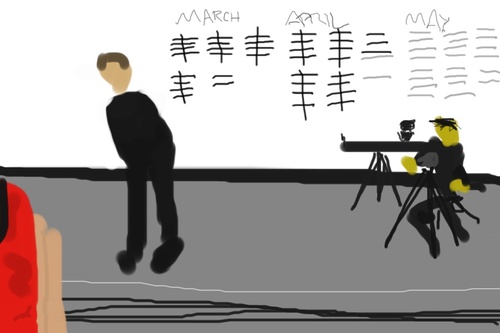
While I’m obviously no David Hockney, after a year or so, I see a Brushes trend emerging: people sitting in front of me.
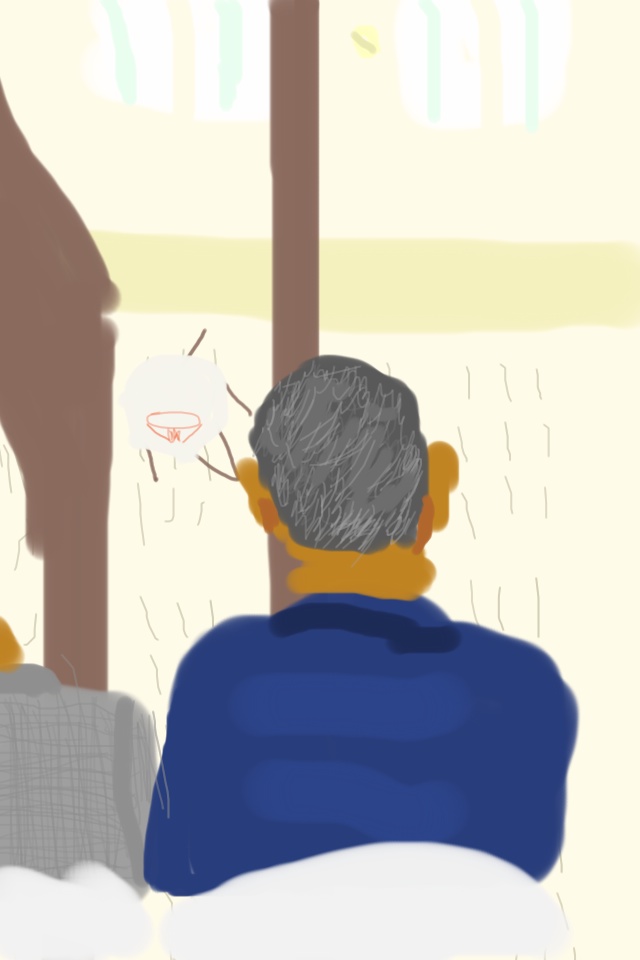
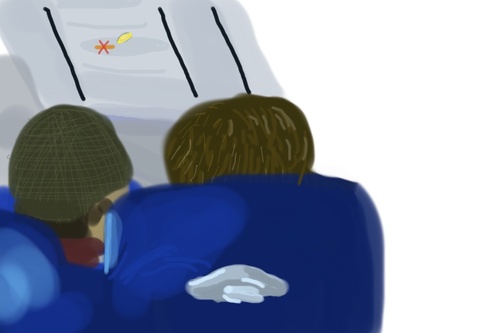
On the most recent one, I decided to pare it down.
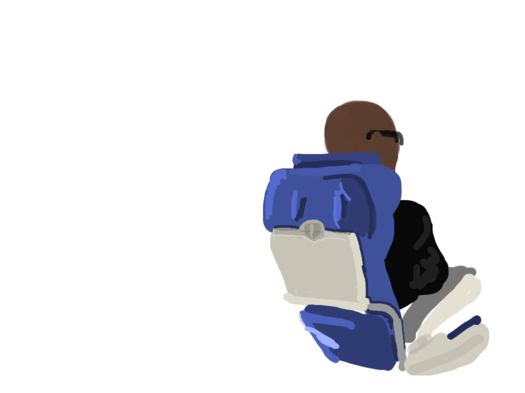
From the width of the seat, you can see I’m able to fly coach.
Now that everyone’s a courtroom sketch artist, I wonder on the state of iPad-based reporting. Is anyone not named Steve Mumford sketch-reporting from a war zone? Is anyone not named Ruben Toledo doing front-row sketches from the fashion shows? [If so, would they acknowledge they’re not actually in the front row by including the heads of the people sitting in front of them?]
Or are both of those scenes too fast? Does Brushes require an element of boredom, or at least waiting, downtime, to make it work as a live medium? Or maybe you draw the audience while Marc Jacobs makes everybody wait for Rihanna or whoever to arrive?
On Stage
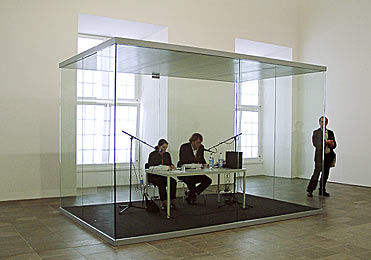
In 2002, as I was still trying on various kinds of public writing, I tried to capture the transformative experience of listening to–no, experience is the better word–On Kawara’s One Million Years.
That post was even titled like a screenplay: “Setting: Fredericianum, Documenta II, Kassel.”
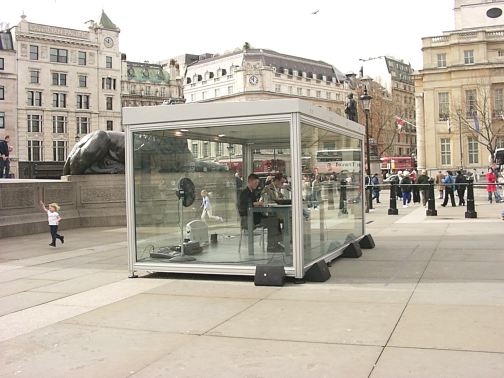
image via mightymac
In April 2004, South London Gallery staged a week-long, round-the-clock marathon reading of One Million Years in Trafalgar Square. Many passersby unfavorably compared Kawara’s volunteer readers in their glass box to David Blaine, who had, just a few months before, spent 40 highly publicized days in a plexiglass cube suspended from a crane next to the Thames.
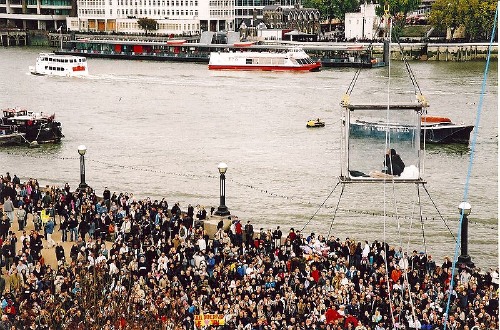
In 2009, when David Zwirner staged a reading/recording of One Million Years, Brian Sholis wrote touchingly and with great acuity about the experience of reading the years 79,936 AD – 80,495 AD with his then-fiancee.
And yet only just now, somewhere between finding Jerry Saltz’s characteristically gossipy, angst-ridden account of reading in the same show, and watching this comical YouTube video of Martin C. de Waal, a Dutch club kid/stylist/Orlan-style conceptual self-portraitist and his dance remix singing partner Marina Prins [!] getting all dolled up for their reading on the open platform at the Stedelijk–the one we’d been standing on a few weeks ago–do I realize the powerful performative essence of Kawara’s piece. And with less than a hundred of an anticipated 2,700+ CDs burned, it’s barely even begun.
The effect of living in a post-Marina world, I suppose
Q For Institutionally Affiliated Readers Of greg.org: Res 10?
If you can see the full text of “On Collaboration In Art,” David Shapiro’s conversation with John Cage, published in the Autumn 1985 issue, (No. 10) of Res: Anthropology and Aesthetics, perhaps you can tell me if it does, in fact, discuss Rauschenberg and Johns’ work on Short Circuit as the web-based search appears to indicate?
Thanks!
On Collaboration in Art: A Conversation with David Shapiro
David Shapiro and John Cage
RES: Anthropology and Aesthetics
No. 10 (Autumn, 1985), pp. 103-116 [jstor.org]
update: Thanks to greg.org readers B and G, we know the answer is yes, yes it does, and wow, very interesting. Here is Shapiro asking his friend Cage about Black Mountain and how he perceives collaboration:
DS: So collaboration also implied simultaneity?
JC: That’s all it really means to me.
DS: Two things happening at the same time.
JC: That is their relationship.
DS: Bob Rauschenberg often seems optimistic, inclusive, as if he’s marrying the whole world, like permitting Jasper Johns’s flag to be inside a larger sculpture. It seems like a sign of generosity. He sometimes seems generous in his collaborative spirit. You don’t think of it as necessarily emotionally generous to collaborate? Is it not a sign of charity?
JC: No. It’s a willingness to have your work experienced at the same time other work is experienced. I’m being careful not to use the expression “willingness to come together,” because there’s no coming together really. It’s two different different things that if they do come together at all, they come together where Marcel [Duchamp] said a work of art was completed, in the observer. But the two people who are collaborating are not observers until they can be. Then, when they are observers, they’re no longer collaborators.
I was going to add italics for the rather salient language these folks were using, but well, where to stop?
Hirshhorn curator Cynthia McCabe was there, too, and Shapiro’s wife, the architect Lindsay Stamm Shapiro. McCabe really wanted Short Circuit for the Hirshhorn’s 1985 exhibition, “Artistic Collaboration in the Twentieth Century”:
CM: We just had a very sad experience looking at the Rauschenberg Short Circuit that Jasper had done with him and Susan Weill [sic]. It’s now in a state of real disrepair. It’s so important for this exhibition.
LS: Where is it?
DS: It’s in Rauschenberg’s studio, but Johns’s flag had been stolen at the place. It had been shown at Finch College. It is like a wing to an altarpiece, and inside was a Susan Weill. I’m sure you’ve seen it.
CM: There was a little sticker in there, I’m trying to think of which was the work, it says “Cage.”
DS: Yes, it has a little collage mentioning a performance that you had done. I think with David Tudor. When David Tudor does chord clusters in the record indeterminacies, was that collaborative or completely mapped out by you, so he’s the performer?
JC: He’s playing the Solo for Piano from the Concert for Piano and Orchestra.
From Solomon’s ‘The New Art’
A little Saturday stenography. Alan Solomon wrote “The New Art,” a catalogue essay for “The Popular Image,” one of the first museum exhibitions of Pop Art, organized by Alice Denney in the spring of 1963 at the fledgling Washington Gallery of Modern Art. [Solomon would go on to restage the show in the ICA in London that fall, sort of obscuring or usurping Denney’s and the WGMA’s position in the history of Pop.]
Anyway, Solomon, who had just left Cornell to establish the Jewish Museum’s contemporary program, where he gave Rauschenberg his first retrospective, and who would soon be the commissioner at the Venice Biennale where Rauschenberg would be the first American to win the International Painting Prize, discussed both Rauschenberg and Johns, along with Allan Kaprow, as key influences on the nascent Pop Artists. Because no one else seems to have put it online, here are some extended excerpts from Solomon’s essay:
The point of view of the new artists depends on two basic ideas which were transmitted to them by a pair of older (in a stylistic sense) members of the group, Robert Rauschenberg and Jasper Johns. A statement by Rauschenberg which has by now become quite familiar implicitly contains the first of these ideas:
Painting relates to both art and life. Neither can be made. (I try to act in the gap between the two.)
Rauschenberg, along with the sculptor Richard Stankiewicz, was one of the first artists of this generation to take up again ideas which had originated fifty yeras earlier int he objects made or “found” by Picasso, Duchamp, and various members of the Dada group. Raschenberg’s statement, however, suggests a much more acute consciousness of the possibility of breaking down the distinction between the artist and his life on the one hand, and the thing made on the other.
